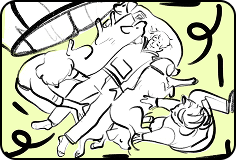Problem that will teach you to make only the right decisions
Doctors, entrepreneurs, diplomats, politicians and ordinary people solve this problem every day when they are faced with the problem of making the right choice and finding the best solution from a variety of options.
In order to practice the technology of making quick and correct decisions, let’s close our eyes and move to a major car exhibition, where every automaker invites you to choose the car of your dreams.
Or let’s run into a real estate company where all the houses of your dreams are collected.
Or let’s find ourselves at a job interview where all your dream candidates show up at the same time.
Or just imagine any place where you have:
- a variety of options
- limited time to make a decision
- the need to make the right, and sometimes the only, choice towards your dreams
Imagined? Now you can open your eyes and read some of your dream solutions.
When you are dealing with a variety of options that are good in their own way and at the same time bad in their own way, you can rely on chance – toss a coin, remember a little counting rhyme or choose something without looking.
You can always choose only the first option, but then the likelihood of making the right decision becomes very small.
You can rely on authoritative advice from friends. You can philosophize and remember the phrase: “What is not yours will not be yours.”
You can break the system and not agree to the imposed framework or imposed deadlines. You can just start trying all the options.
It is possible not to choose the best solution, but instead to choose the best consequence. Or you can stop looking for only the right solutions and just enjoy the choice.
Mathematicians from different countries thought about how to teach people to always make only the right decisions, and here are the conclusions they came to:
We can determine the total number of objects from which we need to make the right choice (for example, if we want to choose the best of all cars, we determine the total number of all cars from which we need to make a choice) – N
We choose the first R from them – we carry out a test drive and remember the characteristics of the best car among them. But at this stage we are not making a decision yet.
We take the characteristics of the best car from the first R cars as the basic level.
Then we start looking at the rest of the cars (miracles of the automotive industry).
The first iron horse, the level of which exceeds the basic level you have chosen in terms of characteristics, is the car of your dreams and you buy it.
In general, it looks like this:
R = N/e,
where e is Euler’s number, which approximately equals to 2.7182818285. This means that if you choose from 100 cars, you need to reject about 38 of them, and starting from the 39th, to buy one the level of which is higher than the basic level.
But in real life there are much more often situations when we do not know in advance how many objects we have to choose from. It may turn out that they will end before we begin to implement the mathematical strategy.
Since we don’t know how many properties there will be in total (they may show you 3 houses, and then offer to look at 10 more. 20 people may come to you for an interview, and the next day there will not be a single application), we will not be able to evaluate the first quarter, because we do not know when this quarter ends.
To get out of this situation, we came up with this:
We don’t know how many objects we have, but we know the time within which we must make a decision. That means we can count the time we have and divide it by Euler’s number. During this time, we find the best object and use its level as the basic one.
It turns out that if we have exactly a month to find a house, then for about 10 days we look at houses and do not make any decisions, while we write down the level of the house with the best characteristics, and take these characteristics as the basic level. And starting from the second decade, we look at more houses and immediately take the one that is higher than the found basic level. But we have greatly simplified that; of course, in the formulas everything is much more complicated.
All you have to do is make a choice and check how well this algorithm helps you make only the right decisions. Still a choice.

A navigator determines the current location of a person on Earth. We’re mapping new routes in your consciousness.
Thank you!




